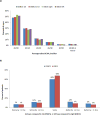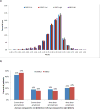Immediate Sequential vs. Delayed Sequential Bilateral Cataract Surgery: Retrospective Comparison of Postoperative Visual Outcomes
- PMID: 28438415
- PMCID: PMC5531866
- DOI: 10.1016/j.ophtha.2017.03.034
Immediate Sequential vs. Delayed Sequential Bilateral Cataract Surgery: Retrospective Comparison of Postoperative Visual Outcomes
Abstract
Objective: We conducted a retrospective comparative-effectiveness study of best-corrected visual acuity (BCVA) and refractive error (RE) after immediate sequential (ISBCS) and delayed sequential (DSBCS) bilateral cataract surgery. We tested 2 hypotheses: (1) among DSBCS patients, second-eye outcomes were no different than first-eye outcomes; (2) averaged between each patient's 2 eyes, outcomes did not differ between ISBCS and DSBCS patients.
Design: Retrospective comparative-effectiveness study.
Participants: Kaiser Permanente Northern California members who underwent noncomplex bilateral cataract surgery from January 1, 2013, through June 30, 2015.
Methods: We performed an intention-to-treat analysis comparing ISBCS to DSBCS using conditional logistic regression analysis, accounting for surgeon and patient-level factors.
Main outcome measures: BCVA, RE.
Results: The analysis of visual outcomes included both eyes of 13 711 DSBCS and 3561 ISBCS patients. Because of the large sample size, some statistical differences lacked clinical significance. Ocular comorbidities were slightly more prevalent in DSBCS patients. Postoperative BCVA was 20/20 or better in 48% of DSBCS first eyes, 49% of DSBCS second eyes, 53% of ISBCS right eyes, and 51% of ISBCS left eyes. The within-person difference in postoperative BCVA averaged zero (0.00) between the first and second DSBCS eyes, and between the ISBCS right and left eyes. After adjustment, average postoperative BCVA was better in ISBCS patients, although the difference was not statistically significant (compared with 20/20 or better: odds ratio for worse than 20/20 was 0.91, 95% confidence interval 0.83-1.01). Emmetropia (spherical equivalent -0.5 to 0 diopter) was achieved in 61% of first DSBCS eyes, 61% of second DSBCS eyes, 63% of ISBCS right eyes, and 63% of ISBCS left eyes. After adjustment, average postoperative RE was no different in ISBCS compared with DSBCS patients (compared with emmetropia: odds ratio for ametropia was 1.02, confidence interval 0.92-1.12). We confirmed 1 case of postoperative endophthalmitis in 10 494 ISBCS eyes (1.0 per 10 000 eyes) and 2 cases in 38 736 DSBCS eyes (0.5 per 10 000 eyes) (P = 0.6), and no patient had bilateral endophthalmitis.
Conclusions: Compared with DSBCS, we found no evidence that ISBCS was associated with worse postoperative BCVA or RE, or with an increased complication risk.
Copyright © 2017 American Academy of Ophthalmology. Published by Elsevier Inc. All rights reserved.
Conflict of interest statement
Figures


Similar articles
-
Refractive Outcomes After Immediate Sequential vs Delayed Sequential Bilateral Cataract Surgery.JAMA Ophthalmol. 2021 Aug 1;139(8):876-885. doi: 10.1001/jamaophthalmol.2021.2032. JAMA Ophthalmol. 2021. PMID: 34196667 Free PMC article.
-
Endophthalmitis Rate in Immediately Sequential versus Delayed Sequential Bilateral Cataract Surgery within the Intelligent Research in Sight (IRIS®) Registry Data.Ophthalmology. 2022 Feb;129(2):129-138. doi: 10.1016/j.ophtha.2021.07.008. Epub 2021 Jul 13. Ophthalmology. 2022. PMID: 34265315 Free PMC article.
-
Trends, Factors, and Outcomes Associated with Immediate Sequential Bilateral Cataract Surgery among Medicare Beneficiaries.Ophthalmology. 2022 May;129(5):478-487. doi: 10.1016/j.ophtha.2021.12.015. Epub 2021 Dec 28. Ophthalmology. 2022. PMID: 34971649
-
Immediate sequential vs delayed sequential bilateral cataract surgery: systematic review and meta-analysis.J Cataract Refract Surg. 2023 Nov 1;49(11):1168-1179. doi: 10.1097/j.jcrs.0000000000001230. J Cataract Refract Surg. 2023. PMID: 37276258
-
Immediately sequential bilateral cataract surgery.Curr Opin Ophthalmol. 2024 Jan 1;35(1):17-22. doi: 10.1097/ICU.0000000000001003. Epub 2023 Oct 19. Curr Opin Ophthalmol. 2024. PMID: 38390776 Review.
Cited by
-
American Academy of Ophthalmology Intelligent Research in Sight (IRIS®) Registry and the IRIS Registry Analytic Center Consortium.Ophthalmol Sci. 2022 Jan 8;2(1):100112. doi: 10.1016/j.xops.2022.100112. eCollection 2022 Mar. Ophthalmol Sci. 2022. PMID: 36246182 Free PMC article. No abstract available.
-
Cost-effectiveness of immediate versus delayed sequential bilateral cataract surgery in the Netherlands (the BICAT-NL study): study design of a prospective multicenter randomised controlled trial.BMC Ophthalmol. 2020 Jun 29;20(1):257. doi: 10.1186/s12886-020-01521-x. BMC Ophthalmol. 2020. PMID: 32600295 Free PMC article. Clinical Trial.
-
Patient Attitudes and Desirability Regarding Immediate Sequential Bilateral Cataract Surgery.Clin Ophthalmol. 2022 Apr 29;16:1375-1381. doi: 10.2147/OPTH.S363327. eCollection 2022. Clin Ophthalmol. 2022. PMID: 35520108 Free PMC article.
-
Comment on: 'How to defuse a demographic time bomb: the way forward?'.Eye (Lond). 2018 Jun;32(6):1153. doi: 10.1038/s41433-017-0012-0. Epub 2018 Feb 9. Eye (Lond). 2018. PMID: 29422667 Free PMC article. No abstract available.
-
Refractive outcomes of immediately sequential bilateral cataract surgery in eyes with long and short axial lengths.BMC Ophthalmol. 2024 Feb 20;24(1):77. doi: 10.1186/s12886-024-03347-3. BMC Ophthalmol. 2024. PMID: 38378504 Free PMC article.
References
-
- Olsen T. Use of fellow eye data in the calculation of intraocular lens power for the second eye. Ophthalmol. 2011;118:1710–15. - PubMed
-
- Jivrajka RV, Shammas MC, Shammas HJ. Improving the second-eye refractive error in patients undergoing bilateral sequential cataract surgery. Ophthalmol. 2012;119:1097–1101. - PubMed
Publication types
MeSH terms
Grants and funding
LinkOut - more resources
Full Text Sources
Other Literature Sources
Medical

